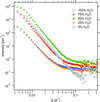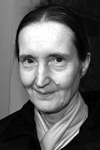issue contents
February 2017 issue

Cover illustration: Schematic representation of the new synchrotron X-ray powder diffraction instrument for long-duration experiments at Diamond Light Source. Courtesy of Murray et al. [J. Appl. Cryst. (2017), 50, 172-183].
research papers
Absorption measurements made using an ultra-thin (0.98/0.67 µm) Ti–Ni foil were used to fit Ni mass absorption coefficients just beyond the Ni K edge, with uncertainties of ±1%. A comprehensive list of mass absorption coefficients was compiled in the near-edge region, providing a significant improvement over existing coefficients present in the NIST XCOM and FFAST databases.
Open  access
access
 access
accessQuantitative analysis of the X-ray pair distribution function collected on calcium silicate hydrates having Ca/Si ratios ranging between 0.57 and 1.47 was applied. With increasing Ca/Si ratio, Si bridging tetrahedra are omitted and Ca(OH)2 is detected at the highest ratios.
On the basis of studies using a combination of differential thermal analysis, visual polythermal analysis and solid state synthesis, a detailed investigation into phase formation in the ternary reciprocal system Li, Ba // BO2, F has been carried out and its importance in growing barium borate crystals has been shown. The liquidus of the system is composed of primary crystallization fields of six compounds – BaB2O4, BaF2, LiBaF3, LiF, LiBO2 and LiBa2B5O10 – separated by co-crystallization curves and four nonvariant points.
Energetically less favourable [ ]-oriented GaN faceted domains on an SiO2-patterned m-plane sapphire substrate are grown for the first time utilizing spontaneous polarity inversion.
]-oriented GaN faceted domains on an SiO2-patterned m-plane sapphire substrate are grown for the first time utilizing spontaneous polarity inversion.
This paper reports the characterization of the atomic structure of a series of glass-like carbons by wide-angle neutron and X-ray scattering and molecular dynamics simulations.
A powerful methodology including time-of-flight neutron diffraction is applied in order to determine the chemical compositions of as-cast and annealed ternary alloys (Cu–Zn–Sn), produced in controlled workshop conditions.
The impact of precursor and activator chemistry on the development of nanosized pores in alkali-activated materials has been determined using small-angle neutron scattering. The emergence of pores during the initial 24 h of reaction has been quantified, with contrast variation showing that the dominant source of scattering is from pores in this type of sustainable cement.
This work describes a semi-empirical attenuation correction that has been developed for neutron time-of-flight measurements with diamond-anvil cells.
The combination of high-pressure neutron diffraction and total scattering of crystalline materials presents several unique challenges to established data collection and analysis methods. This paper presents a simple reproducible method for the acquisition of high-quality neutron total scattering data from crystalline materials at high pressure.
The variability in the number of water molecules localized in protein crystallography depends not only on the crystallographic resolution but also on other parameters. A multiple Poisson regression allows its estimation.
In order to improve the possible precision and accuracy of lattice parameter determination from the features observed in Kikuchi patterns, some useful fundamental relationships of geometric crystallography are reviewed.
Experiments and simulations are used to evaluate the applicability of multigrain crystallography for high-pressure diamond anvil cell experiments. The method allows the retrieval of a large portion of the illuminated sample grains with an average theoretical resolution in grain orientation of 0.02° and a spatial resolution that requires further improvement.
Precision and accuracy in the determination of elastic stress are determined in the case of portable testing equipment using area detectors for in situ/in-line applications.
A method for obtaining self-standing bent monocrystals is proposed. The crystal curvature was interpreted and parametrized, while the crystallographic quality was verified using hard X-ray diffraction at the DIGRA facility (Institut Laue–Langevin, Grenoble, France).
The thermal stability of highly defective nanotwinned thin Cu–Mo and Ag–Mo films was investigated using X-ray diffraction and high-resolution transmission electron microscopy. The exposure of segregation and precipitation processes leads to partial stabilization of the nanostructure in the Cu–Mo film and to full stabilization of the nanostructure in the Ag–Mo film, in accordance with thermodynamic and kinetic analyses performed as well.
Open  access
access
 access
accessThe world's first dedicated synchrotron instrument for long-duration experiments has been built and commissioned at Diamond Light Source. The new beamline I11 user facility is designed for the study of slow kinetics in polycrystalline materials.
Long-range interface roughness correlation in Ni–Ti neutron supermirrors is found to manifest in plateaus and peaks in the diffuse neutron scatter. The features are of resonant character and are strongly dependent on the type of the supermirror structure (slowly increasing or decreasing bilayer thickness). Distorted wave Born approximation calculations yield the statistical parameters of the interface roughness correlations.
The size and size anisotropy of nanocrystals is determined together with the distribution of amorphous phases inside a seven-capillary model reactor filled with various nanomaterials. This is achieved by diffraction scattering computed tomography followed by Rietveld refinement and multivariate analysis of Rietveld backgrounds.
High-resolution and high-intensity neutron diffraction was applied to characterize the atomic and magnetic structure and microstructure of Fe–27Ga alloy in the as-cast and powder states. Structural phase transformations occur with a noticeable difference in the as-cast and powder states of the alloy.
This manuscript demonstrates an entirely different numerical approach for profile modeling/fitting of diffraction peaks, Bayesian statistics combined with a stochastic sampling algorithm, which substantially increases the fidelity of information available in characterizing domain reorientation in ferroelectric materials.
This work presents a new optimization procedure, elaborated for the decomposition of wide-angle X-ray diffraction curves of semicrystalline polymers, based on the particle swarm optimization method, one of the most effective artificial intelligence methods. It is shown that the effectiveness and convergence of the elaborated system are better than the related parameters of other algorithms.
This work sheds some light on the impact of the SiO2/Al2O3 ratios of aluminosilicate sols on structure evolution, including particle size, fractal dimension, and the interplay between the fractal dimension and the activity to generate NaY zeolite. The mechanisms regulating the growth behaviour of the sols during ageing are proposed.
A variety of physically meaningful geometrical and preferred orientation corrections are derived and summarized. The application of these corrections allows for realistic modelling based on the fundamental parameters approach to be undertaken.
Four different X-ray methods are introduced, which allow for depth-resolved residual stress analysis in thin films with a chemical composition gradient.
Four different X-ray methods are demonstrated experimentally, which allow for depth-resolved residual stress analysis in thin films with a chemical composition gradient.
Transparent p-terphenyl single crystals were grown by the vertical Bridgman technique with conventional and improved double-wall growth ampoules. The enhanced crystalline perfection and fluorescence properties of the improved-ampoule-grown crystal suggest that the vertical Bridgman growth method with the modified growth vessel is effective for growing high-quality bulk single crystals of low-melting-point organic materials.
short communications
The degree of completeness of the β→ω transformation in a metastable β titanium alloy has been determined by X-ray diffraction.
computer programs
Open  access
access
 access
accessThis article presents a powerful yet simple program, based on the general one-dimensional kinematic X-ray diffraction (XRD) theory, which calculates the XRD patterns of tailor-made multilayers and thus enables quantitative comparison of measured and calculated XRD data. As the multilayers are constructed layer by layer, the final material stack can be entirely arbitrary.
WinPSSP is a computer program running in the Windows OS based on the code of PSSP, applying direct-space methods to solve the crystal structures of small-molecule organic materials from X-ray powder diffraction data.
Open  access
access
 access
accessSUePDF: a program to obtain quantitative pair distribution functions from electron diffraction data
SUePDF is software to convert electron diffraction data to quantitative pair distribution functions.
CBED Tools, a free plugin for the DigitalMicrograph software, is capable of fast and accurate measurements of crystal thickness and extinction distance based on the linear fitting method of convergent-beam electron diffraction (CBED) patterns. This tool is also able to perform thickness determination for very thin crystals when the traditional CBED thickness analysis does not work and to analyse the severely distorted fringes obtained when zero-order Laue zone Kikuchi lines strongly overlap with Kossel–Möllenstedt fringes.
Oscail provides facilities for small-molecule crystal structure solution and refinement based on SHELX and Superflip. Lattice analysis, crystal morphology prediction, high-quality graphics and an interface to molecular modelling are also provided.
laboratory notes
A new crystallization plate (the MPI tray) has been developed for UV and visible imaging with membrane protein samples. Optimization of the surface properties fundamentally enhances the usability of the plate, even in the presence of detergents.
crystallographers
Free 

book reviews
Free 



 journal menu
journal menu





















































